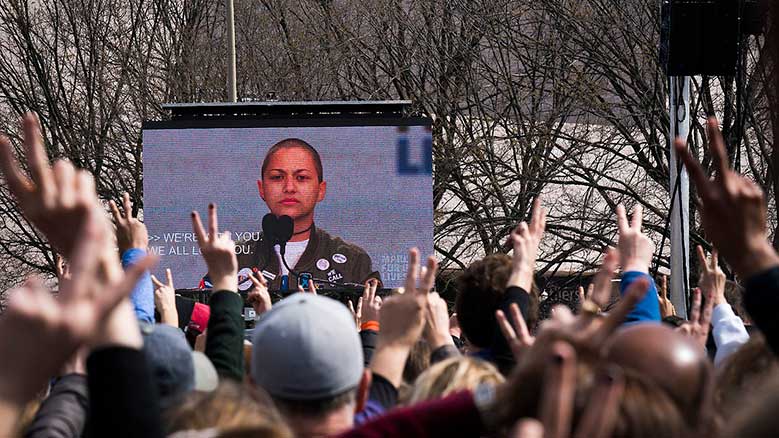
On February 13, 2018, Emma Gonzalez was a typical high school senior: she was president of Marjory Stoneman Douglas High School’s (MSD) Gay Straight Alliance, loved creative writing and science, and had about 200 Twitter followers. On February 14, a shooter entered her school in Parkland, Florida, killing 17 people. Three days later, Gonzalez spoke at a rally in Ft. Lauderdale, and her now-famous 11-minute “We call B.S.” speech about lax gun laws went viral, broadcast live by attendees at the rally via Facebook and Twitter. That speech was the beginning of a movement that has rallied thousands of children and adults in school walkouts, precipitated the Washington March for Our Lives a month after the shooting, and started voter-registration drives across the United States.
In the weeks following the shooting, Gonzalez and many of her classmates developed the #NeverAgain movement, growing a worldwide social media following. This includes celebrities supportive of their cause who offered large donations to fund the march in Washington, D.C. Hundreds of marches across the country were planned concurrently in support of sensible gun legislation.
As Gonzalez and her friends saw their Twitter followers increase, they used the platform to tweet invitations to perform in Washington to entertainers like Miley Cyrus, Ariana Grande, and Jennifer Hudson. They connected via Twitter to students in Chicago and Washington, D.C., where gun violence happens with regularity, and the Parkland students made sure that the speakers at the Washington event included African American and Latina voices, underscoring the cross-sectional impact guns have on all neighborhoods. Without social media, the students would not have connected so easily to advocates around the country who could lend support, funding, and influence in the movement’s formation.
In the weeks that followed, Gonzalez and her classmates kept the conversation going on social media, launching a boycott of Fox News’ Laura Ingraham for her derogatory comments about Marjory Stoneman Douglas student David Hogg. MSD students started an Instagram account that pokes fun at the clear backpacks MSD students are now required to use, interjecting student-generated content with memes reminding 18-year-olds to register to vote. Within two months of the shooting, Gonzalez alone had 1.5 million Twitter followers, and many of her classmates had hundreds of thousands. It is a platform they now use almost solely to grow the #NeverAgain movement by engaging an audience larger than any major newspaper or cable television provider in the country.
As Friends wrestle with questions surrounding our growth, relevance, and legacy, the work of 18-year-olds like Emma Gonzalez is a blueprint that Quakers need to examine. For Friends who see social media as frivolous or who are risk-averse in light of the recent Cambridge Analytica privacy scandal, it’s important to reflect on the spaces where Jesus found himself most comfortable and where he made the greatest spiritual impact: among regular folks, including outcasts and nonbelievers.
Whether we embrace social media platforms or not, they have become our town squares: equalizing access to everyone, providing a platform for the marginalized and a library for seekers. We need to be there. Of the 2.2 billion Facebook users and 330 million Twitter followers worldwide, how do those who may be receptive to what we believe find out that we even exist?
A website is not enough, and frankly, many Quaker websites do not provide the content that would draw in potential attenders. Here’s an exercise: do an Internet search for “Quakers, (any location).” When you click on the website for your first search result, does the first thing you see tell you anything about what Quakers believe? My guess is that what you’re reading tells you what they’re not: no fixed creed, no ministers, no doctrine. People who are researching faith communities really do want to understand the congregation’s beliefs.
If discerning beliefs for an entire meeting is too difficult, could we profile those who are comfortable sharing specifics about their faith in videos or photos? Part of the reason our digital footprint is so vague is our never having taken the time to go through the process critical to our survival: strategic planning.
Almost every organization that we work or volunteer for engages in planning. The process usually starts by developing a vision, creating long- and short-term goals, and evaluating results in a spirit of continuous improvement. While Friends may resist a process that is associated with corporations and making profits, a thoughtful, careful discussion of who we are and what we want our meeting to become can be done in the spirit of worship. For Quaker meetings, how might that look?
Establishing the Vision
Quakers love committees. Most meetings have lots of them, but if each committee isn’t working to support the meeting’s vision, they are limiting the meeting’s ability to do its best work. A meeting’s vision might be “To Build the Beloved Community” or “To Live in Right Relationship With All Creation,” but whatever it is, it needs to be developed by the entire community, not just conveners, committee representatives, or by the Friends who usually attend meeting for worship with attention to business.
The visioning process might start with a number of worship-sharing exercises as a meeting, followed by some small group discussions where Friends consider queries that may arise from the large-group sessions. The emerging vision needs to be ambitious enough to challenge Friends to bring their best selves to their faith community, yet broad enough for Friends to experience success and fulfillment in their work and worship.
Create Long-term Goals
Once a vision is discerned, what does that mean for a meeting’s growth for the next five years? If the vision is “To Build a Beloved Community,” does a meeting need to attract members whose age, ethnicity, or life experience aren’t currently sitting on the benches? What are specific goals a meeting would need to achieve to make that happen? They may be things like “Increase attendance by persons of color by 15 percent within five years,” “Establish a prison ministry within two years,” or even “Provide $500 per year in sustaining support to Malcolm X Middle School’s conflict resolution program.”
Develop Short-term Goals
This is where committees come in. Once a meeting’s specific long-term goals are discerned, Friends should discuss whether they have the appropriate committees in place and how each committee might work toward those goals. If a long-term goal is to “Increase attendance by persons of color by 15 percent within five years,” a meeting’s Property Committee might set a short-term goal of selling or renting out an existing meetinghouse in order to relocate to a neighborhood where those potential new Friends may live. The First-day School Committee may consider planning service projects with Sunday schools or after school programs in that neighborhood. The Ministry Committee might plan to partner with another faith community and use Latasha Morrison’s “Be the Bridge” curriculum to begin dialogue about racial unity. Each committee should have the opportunity to identify how their work can contribute to the meeting’s long-term goals and whether they may need additional committee members or ministerial support in order to do their best work.
Plan, Do, Study, Act (PDSA)
A meeting’s planning process is continuous: developing a plan to test the change, carrying out the test (do), studying the results, and determining what modifications should be made to the test (act). The PDSA cycle also offers accountability and a framework for dialogue that may shine a spotlight on committees that aren’t regularly heard from.
While a meeting may just be grateful that someone has offered to oversee hospitality for the year, that committee’s work now supports a goal for increased membership. Friends on the Hospitality Committee may now be able to go beyond making coffee each First Day to developing surveys to learn more about what Friends like to eat, whether there are enough child-friendly options, and whether the seating area is comfortable and conducive to fellowship.
All of this good work is the germ for a flourishing digital footprint, rich with images and video of long-term members and brand-new attenders working toward realizing God’s Kingdom. It is the basis for queries arising from worship that can be tweeted and tagged with handles from Friends in Great Britain (@BritishQuakers), New England (@QuakersofNE), and Indiana (@richmondfriends) to explore understanding together in a way that only digital outreach can provide.
Digital ministry is what has drawn together disparate Friends into the Friends of Jesus Fellowship (on Facebook: @Friends.of.Jesus.Fellowship), what has helped non-Quakers learn who Friends are through the QuakerSpeak video series, and what has engaged Friends worldwide in conversations about improving ministry, welcoming newcomers, and developing a First-day school curriculum that grows our membership.
Social media is being used effectively by faith communities like @TheSlateProject, who host regularly scheduled Twitter gatherings that begin with a query or reflection that encourages engagement. Hashtags like #NationalDayofPrayer are a tool used to discover non-Quaker thought leaders like James Martin, SJ (@JamesMartinSJ), or Rev. Dr. William J. Barber (@RevDrBarber). The more than 400 tweets about theologian Yolanda Norton’s #BeyonceMass at Grace Cathedral in San Francisco encourage a conversation about womanist biblical interpretation and how pop culture can encourage accessibility to experiential spirituality. Social media provides endless opportunities for outreach, ministry, and learning, yet most meetings are exploring none of them.
In order for the Religious Society of Friends to flourish, it is imperative that we embrace a call to create engaging websites and social platforms that are visually appealing and mobile friendly with clear communication of our beliefs and vision. If we recognize the importance of growing our membership, we need to recognize that just as Jesus encouraged his followers to leave behind their 99 sheep to bring back the one who was lost, we may find today’s lost sheep scrolling through a Twitter feed on their iPhone in hopes of finding a spiritual connection they’ve drifted from or possibly never encountered. Let’s get #Quakers trending.
Strategic Planning Tips
Visioning Phase
- Consider asking a visiting Friend to lead these sessions so that the entire meeting can be fully engaged. At the conclusion of your process, identify Friends within the meeting who are willing to offer the same ministry to other meetings with a desire to do the same.
- See how simply the meeting can communicate the vision. Share it widely: on signage, letterhead, digital media, and in interactions with community members.
Long-term Planning Phase
- Make sure to engage young Friends in this process. The goal is for them to be around to help carry out the plans!
- If the meeting is having difficulty reaching consensus on a particular goal, consider setting it aside in order not to delay the next phase. A meeting committed to PDSA planning will be continually evaluating whether the goals set are achieved, which goals need to be revised, and what additional ones are relevant now but may not have been a year ago.
Short-term Planning Phase
- Remind Friends that just because each committee should find ways to support each of the meeting’s goals doesn’t mean that committees have more work. It just may be different work than before.
- This phase is an opportunity to reconsider a meeting’s current committee structure, challenge Friends to consider how Friends are introduced to committee work, and how members of a meeting can see their gifts used to their greatest potential.
Continuous Improvement Phase
- Find a way to incorporate the PDSA review process as a regular part of the meeting’s business on a quarterly basis.



Comments on Friendsjournal.org may be used in the Forum of the print magazine and may be edited for length and clarity.